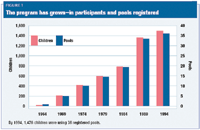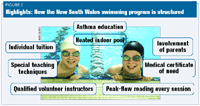When children with asthma go swimming, the benefits can be many and long-lasting
Getting children who have asthma into the water can have remarkable effects on health, the authors' experiences demonstrate. Place a properly structured swimming program on your list of recommendations for these patients, they urge-or put it on your medical community's to-do list.

The history of a swimming program in New South Wales

Second, children who have asthma have difficulty in general swimming classes because it is difficult for them to breathe in water. Instructors often had insufficient understanding of asthma and were unaware of problems encountered by some asthmatic children when learning to swim. Many asthmatic children are, of course, mouth breathers who may have a chest deformity and chronic rhinitis. Even when they are adequately medicated, respiration is inefficient; they experience diminished movement of the diaphragm, nasal obstruction, and recurrent ear and throat infections.4
Most asthmatic children had experienced a fear of death with obstructed breathing; they were terrified, consequently, of their body being immersed in water and of putting their face into water. Many became very apprehensive just standing in water. These children needed to learn correct breathing technique at the outset of a swimming program, but general programs often concentrated on stroke actions first, without early emphasis on the importance of normal breathing. (This is still the case in many general swimming courses.) General swimming programs also often employed flotation aids, which can give children a false sense of confidence.